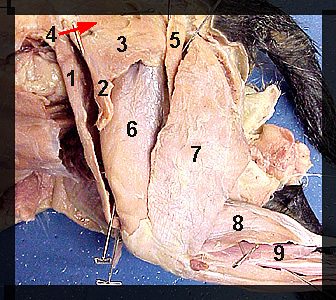|
|
|
|
||||||||||||||||||||||||||||||||||||||||||||||||||||||||||
|
The muscles of the lateral thigh run from the pelvic girdle to either the thigh or the shank . The most anterior muscle of the cat thigh is the sartorius. This muscle appears as a wide, thin band extending from its origin on the ilium to its insertion on the patella and tibia. The action of this muscle is to adduct and rotate the thigh and extend the shank. Posterior to the sartorius, on the lateral surface of the thigh, is the tough and semitransparent fascia lata which extends downward from a triangular muscle, the tensor fascia latae. This muscle originates from the ilium and surface of adjacent muscles and inserts on the dorsal part of the fascia lata. Contraction extends the shank and tightens the fascia lata. The biceps femoris lies posterior to the tensor fascia latae and fascia lata. It is a very broad and thick muscle which arises from the ischium and inserts from the patella to the middle of the shaft of the tibia by means of a wide aponeurosis. Contraction of this muscle abducts the thigh and flexes the shank. A smaller muscle just anterior to the biceps femoris is the caudofemoralis. It originates from the caudal vertebrae and inserts by a thin tendon on the patella. Contraction of the caudofemoralis results in abduction of the thigh and extension of the shank. The muscle immediately anterior to the caudofemoralis is the gluteus maximus. This muscle originates from the last sacral and first caudal vertebrae and inserts on the greater trochanter of the femur. The more diagonal fibers anterior to the gluteus maximus form the gluteus medius. The gluteus medius originates primarily from the ilium, last sacral and first caudal vertebrae to insert on the greater trochanter. The gluteus muscles function to abduct the thigh. |
|
